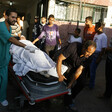The Electronic Intifada Gaza City 20 July 2014

This photo of a boy injured in an Israeli strike clinging to a medic at al-Shifa hospital went viral on the Internet.
APA imagesThursday night, 17 July, was the heaviest yet since Israel’s bombardment of Gaza began almost two weeks ago.
Dozens of people arrived to Gaza City’s al-Shifa hospital, where I was on shift that night. Some arrived torn to pieces, some beheaded, some disfigured beyond recognition, although still alive and breathing.
Seemingly indiscriminate artillery fire, a new element in Israel’s assault, had exacted a heavy toll on civilians.
The medical staff were lucky to get a break of less than half an hour. Some spent it watching the flares and bombs Israel was raining on the eastern neighborhoods of Gaza City, while others refueled with coffee or lay down for a few moments.
The relative calm did not last long. At around 3am, about eight or nine casualties arrived at the emergency room all at once. The last to come in were four siblings — two of them little children, both about three years old, with relatively superficial wounds. But it was clear they were pulled from under rubble, their faces and clothes covered in dirt and dust.
Then came the older of the four siblings, a boy in his early teens. His head and face were covered in blood and he was pressing a rag to his head to stanch the flow. But his focus was on something else: “Save my little brother!” he kept screaming.
The last to arrive was his brother, the child in the above photo that circulated around the world.
“I want my father!”
He was carried in by a paramedic and immediately rushed to the intensive care unit, which is right next to the ER. He clung to the paramedic, crying, “I want my father, bring me my father!” until he had to be forced to let go.
As I stood by, alert for orders, a group of four medical personnel immediately started to treat the boy. But he kept kicking and screaming and calling for his father.
His injuries were serious: a wound to the left side of his head which could indicate a skull fracture and a large piece of shrapnel in his neck. Another piece of shrapnel had penetrated his chest and a third had entered his abdomen. There were many smaller wounds all over his body.
Immediate measures had to be taken to save his life; he was sedated so the medics could get to work.
Upon carefully examining the wounds, it appeared that the explosion from the artillery round sent flying small pieces of stone from the walls of his house, and that some of his wounds were caused by these high-velocity projectiles.
He was extremely lucky: his neck injury was just an inch away from a major artery, his chest injury penetrated all the way through but failed to puncture his lung, and his abdomen was struck by shrapnel that just missed his bowel.
Luck
He had a stroke of luck denied to many that night.
The medics performed heroic measures in a remarkably short time, and the little boy’s life was saved.
Meanwhile in the emergency room, the elder brother was stitched up and the younger two siblings were washed and thoroughly examined for possible hidden injuries.
Somehow, despite the horror and the pain, they were sleeping. I don’t know how they did it, but I felt envious and grateful for the divine mercy that found its way to them.
Their brother with the most serious wounds will almost certainly survive, but with many scars and a difficult recovery period, both physical and psychological.
Too many casualties came in that night, too many for me to get this boy’s name, to know whether he was reunited with his father, or even what became of the rest of his family.
But there’s one thing that I know for sure, which is that hundreds of children just like him suffered similar or worse injuries, and up to the moment of this writing, nearly eighty children just like him have been killed as Israel’s merciless attack goes on.
Belal Dabour is a recently graduated doctor from Gaza, Palestine. He blogs at belalmd.wordpress.com.





